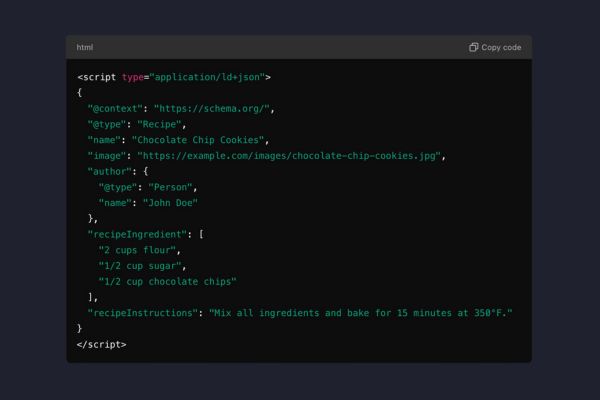Last Updated on February 11, 2025 by Becky Halls
Google Schema Markup is a type of structured data that helps search engines like Google understand your website’s content more effectively. By adding schema markup to your HTML, you enable search engines to create richer, more informative search results, often displayed as rich snippets, which can include images, reviews, and other elements beyond a simple title and meta description.
For marketers, Google Schema Markup is a powerful tool to improve both SEO and user experience. In this article, we’ll explore Google Schema Markup, explain how it works, and highlight its benefits.
What is Google Schema Markup?
In simple terms, Google Schema Markup is a standardized code that you can add to your website’s HTML to help search engines better interpret and display your content in search results. It is part of a larger initiative called Schema.org, which was developed by Google, Bing, Yahoo, and Yandex to create a shared language for structured data on the web.
Schema.org acts as a collaborative initiative established by leading search engines like Google, Bing, Yahoo, and Yandex. It defines a common vocabulary for structured data on the internet. This standardization helps in providing a better understanding of web content, improving the quality of search results. When organizations use Schema.org to structure their data, it ensures compatibility with major search engines, enhancing content interpretation and visibility.
For example, if your website sells products, you can use schema markup to tell Google the product name, price, availability, and even customer ratings. This structured data enhances your search listing and can increase the chances of users clicking through to your site.
Example of a Google Schema Markup
Here’s a simple example of Google Schema Markup for a recipe:

In this example, the schema markup tells Google that the content is a recipe, the author’s name, and the ingredients involved. This structured data improves how this recipe is presented in search results.
Benefits of Google Schema Markup
1. Improved Search Engine Visibility
One of the most significant advantages of using Google Schema Markup is the improved visibility it offers in search results. By enhancing how your content appears, such as through rich snippets, Google is more likely to show your website prominently, which can lead to higher click-through rates (CTR).
Tip: Adding schema markup to your site can help your content stand out, especially for competitive keywords. Listings with additional information such as images, reviews, and FAQs are more engaging to users.
2. Rich Snippets and Enhanced Listings
Schema markup allows Google to create rich snippets—search results that display more than just a URL and meta description. Rich snippets can include elements like ratings, prices, and availability, making the search result more appealing to users.
For instance, if you’re running an e-commerce website, using schema markup for products can show the product price, availability, and customer reviews directly on the search page. This additional information can persuade users to click on your link over a competitor’s.

3. Better User Experience
With Google Schema Markup, users get more relevant information from search results before they even click through to your website. By offering them valuable details like contact information, business hours, reviews, or product prices directly in the search result, you’re improving the user experience.
Tip: Think about the types of content on your website and the additional information that users would find helpful. Use schema markup to present that information in search results to improve the likelihood of users choosing your link.
4. Increased Click-Through Rates (CTR)
Websites that use schema markup often enjoy higher click-through rates (CTR). Since rich snippets provide more context to users, searchers are more likely to click on results that provide the answers they need directly in the search engine results page (SERP).
5. Voice Search Optimization
With the growing importance of voice search, Google Schema Markup plays a crucial role in optimizing your website for voice queries. Structured data helps search engines understand the context of your content more deeply, making it easier for voice assistants like Google Assistant to pull information from your site when answering questions.
SEO Benefits of Specific Schema Types
Understanding how specific schema types impact SEO can refine your strategy. For instance, product schemas are integral for e-commerce, allowing detailed product information like prices and ratings to be evident in search results. Article schemas enhance the visibility of blogs by ensuring headlines, images, and updated times are clearly presented. Similarly, FAQ schemas make common questions and answers more accessible through voice search and rich results, improving user interaction and site engagement.
How to Implement Google Schema Markup
Adding Google Schema Markup to your website can be a straightforward process, especially if you’re using a content management system (CMS) like WordPress.
1. Choose the Right Schema Type
The first step is identifying what type of structured data is relevant to your content. Schema.org has a vast library of schema types that range from articles and products to events, recipes, and organizations.
2. Add Markup to Your HTML
Once you’ve chosen the appropriate schema type, the next step is adding it to your HTML. You can do this manually, or if you’re using WordPress, there are plugins like Yoast SEO and All in One Schema Rich Snippets that make adding schema markup easier.
3. Test Your Markup
Before deploying the markup on your live site, use Google’s Rich Results Test tool to validate your schema code and ensure there are no errors. This tool will also show you a preview of how your markup will appear in search results. Numerous tools can help you implement schema markup with ease. Google’s Structured Data Markup Helper is an excellent resource for beginners, guiding users through the markup process. For those using WordPress, plugins like Yoast SEO and Schema Pro can simplify adding structured data without needing advanced coding skills. These resources help streamline the process, ensuring your markup is both accurate and compliant with search engine standards.
4. Monitor and Update Regularly
Schema markup is not a one-and-done task. As you update your content or add new products, ensure that you update the corresponding schema markup. Regular monitoring helps ensure that your rich snippets stay relevant and appear correctly in search results.
Common Mistakes to Avoid
Avoiding certain pitfalls can ensure effective schema implementation. One common mistake is using incorrect or incomplete schema types, which can mislead search engines and hurt visibility. Failing to validate your schema code might result in errors that prevent it from being recognized. Another oversight is neglecting to update schema data regularly, which can lead to outdated or incorrect information being displayed in search results.
Types of Schema Markup
There are several types of schema that you can implement depending on the nature of your website. Here are some of the most commonly used schema markups:
- Product Schema: For e-commerce websites to display product prices, availability, and ratings.
- Recipe Schema: For food bloggers or websites offering recipes.
- Event Schema: To promote local events with details like location, date, and time.
- Organization Schema: For businesses to provide details about their contact information, location, and hours of operation.
- Article Schema: For publishers and blogs, this helps improve how articles appear in search results.
Latest Updates on Schema Markup Guidelines
Keeping abreast of the latest schema markup guidelines is vital for maintaining SEO efficiency. Recently, search engines have started placing higher value on structured data for voice search results, emphasizing the need for clear and concise markup. This means businesses should prioritize frequently updated schema types like FAQs and How-To schemas to stay competitive. Regularly reviewing these guidelines can ensure your strategies align with current best practices.
Conclusion
Google Schema Markup is an invaluable tool for improving your website’s search engine visibility and enhancing the user experience. By providing search engines with structured data, you enable them to display your content in more attractive, informative ways through rich snippets and other enhanced search features.
For marketers looking to improve their SEO efforts, implementing schema markup is a smart strategy. It not only improves your site’s search presence but also increases click-through rates and enhances user engagement. So, if you’re not already using Google Schema Markup, now is the perfect time to get started!
With these insights into how schema markup works and how it can benefit your business, you’re now equipped to enhance your SEO strategy and deliver a better experience to your users.




